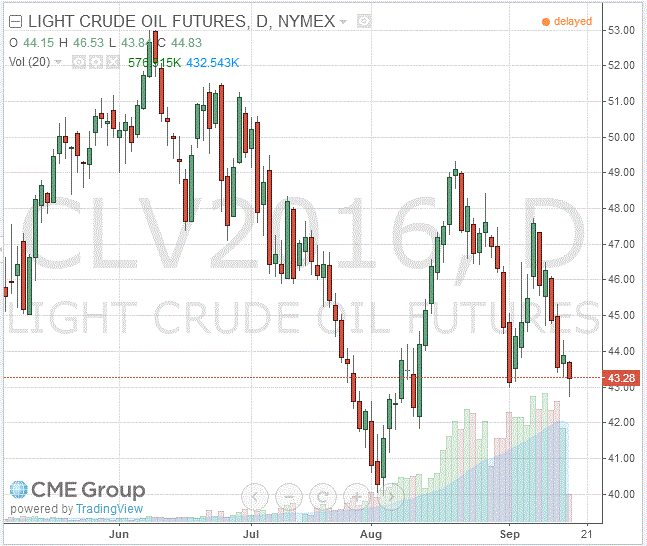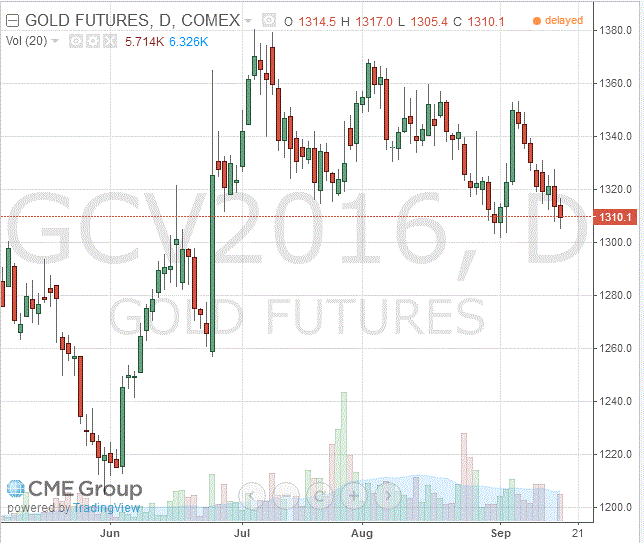Noticias del mercado
-
17:46
Oil falls through important support but recovers
Oil prices fell to multi-week lows as the increase in Iranian exports and the resumption of oil supplies from Libya and Nigeria heightened investors' fears that the global glut will persist.
The cost of oil futures for Brent and WTI fell by 9-10 percent in one week, stressing the volatility in the oil market. "We've seen a lot of bearish news this week. The weak fundamental factors are putting pressure on the market.", - Said Frank Klumpp, oil analyst at LBBW.
Strengthening of the dollar against the backdrop of positive US data also important for oil trading. The US Dollar Index, showing the US dollar against a basket of six major currencies, rose 0.7%. As oil prices are tied to the dollar, a stronger dollar makes oil more expensive for holders of foreign currencies.
Up to August, Iran, the third largest producer of OPEC exports increased by more than 2 million barrels per day. Most of the additional Iran's exports went to Asia and Europe. Daily crude oil imports from Iran and India rose in August to the highest level in at least 15 years. At the same time, Austria's OMV said it has taken delivery of Iranian oil in the port of Italy. It was the first cargo from Iran since 2012.
There are also signs of the resumption of oil supplies from Nigeria and Libya. Earlier, crude oil exports by these countries has been hampered by conflict and unrest. This week, the State Oil Corporation of Libya has removed restrictions on the supply of oil from a number of ports with total capacity of 300 thousand barrels per day. Meanwhile, Exxon Mobil and Royal Dutch Shell said that are ready to resume the supply of Nigerian grade Qua Iboe. According to estimates, Libya and Nigeria may return the market about 800 thousand barrels per day.
The cost of the October futures for US light crude oil WTI (Light Sweet Crude Oil) fell to 43.28 dollars per barrel on the New York Mercantile Exchange.
October futures price for North Sea petroleum mix of mark Brent fell to 46.12 dollars a barrel on the London Stock Exchange ICE Futures Europe.

-
17:30
Gold declines for the second day in a row
Gold fell markedly reaching a two-week low move caused by the publication of inflation data from the US, which increased the likelihood of a hike by Federal Reserve later this year.
US Labor Department said that consumer prices rose more than expected in August as rising rents and health care costs offset a drop in gasoline prices, pointing to a steady build-up of inflation. According to the report, the consumer price index rose 0.2 percent last month after being unchanged in July. In the 12 months to August, the consumer price index increased 1.1 percent after rising 0.8 percent in July. Economists had forecast that the CPI will rise by 0.1 percent for the month and 1.0 percent per annum. The core CPI price which excludes food and energy, rose 0.3 percent, the biggest increase since February, after rising 0.1 percent in July. Core CPI rose by 2.3 percent in the 12 months to August, after rising 2.2 percent in July.
The surge in inflation is likely to be welcomed by representatives of the Federal Reserve when they meet next Tuesday and Wednesday to discuss monetary policy. According to the futures market, the likelihood of tighter monetary policy in September is 15% against 12% the previous day and at the December meeting a hike is estimated at 56.5% compared with 47.4% of the previous day.
"The inflation data were positive for the US dollar, and this put pressure on the gold price - ThinkMarkets, Naeem Aslam -. The precious metal is now trading close enough to the level of technical support $ 1,300, and if we overcome this level, it will be a bearish signal for gold" . The US Dollar Index, showing the US dollar against a basket of six major currencies, rose 0.7%. Since gold prices are tied to the dollar, a stronger dollar makes the precious metal more expensive for holders of foreign currencies.
Gold reserves in the largest investment fund SPDR Gold Trust fell yesterday by 3.3 tons. Meanwhile, the demand for gold in India remained weak which prevented higher prices for precious metals.
The cost of the October futures for gold on the COMEX fell to $ 1310.1 per ounce.

-
11:09
Oil trading lower
This morning, New York crude oil futures for WTI have fallen in price by 0.96% to $ 43.49 and Brent oil futures fell in price by -0.97% to $ 46.15 per barrel. Thus, the black gold is traded lower on the background of concerns about the continuing increase in the number of drilling rigs in the United States, and that the restoration of the supply of oil from Libya and Nigeria exacerbate global oversupply. Data on the number of US rigs from Baker Hughes for the week will be released later today. Recovery of oil supplies from Libya and Nigeria would be an obstacle to the rebalancing of the global oil market.
-
00:30
Commodities. Daily history for Sep 15’2016:
(raw materials / closing price /% change)
Oil 43.70 -0.48%
Gold 1,317.80 -0.02%
-